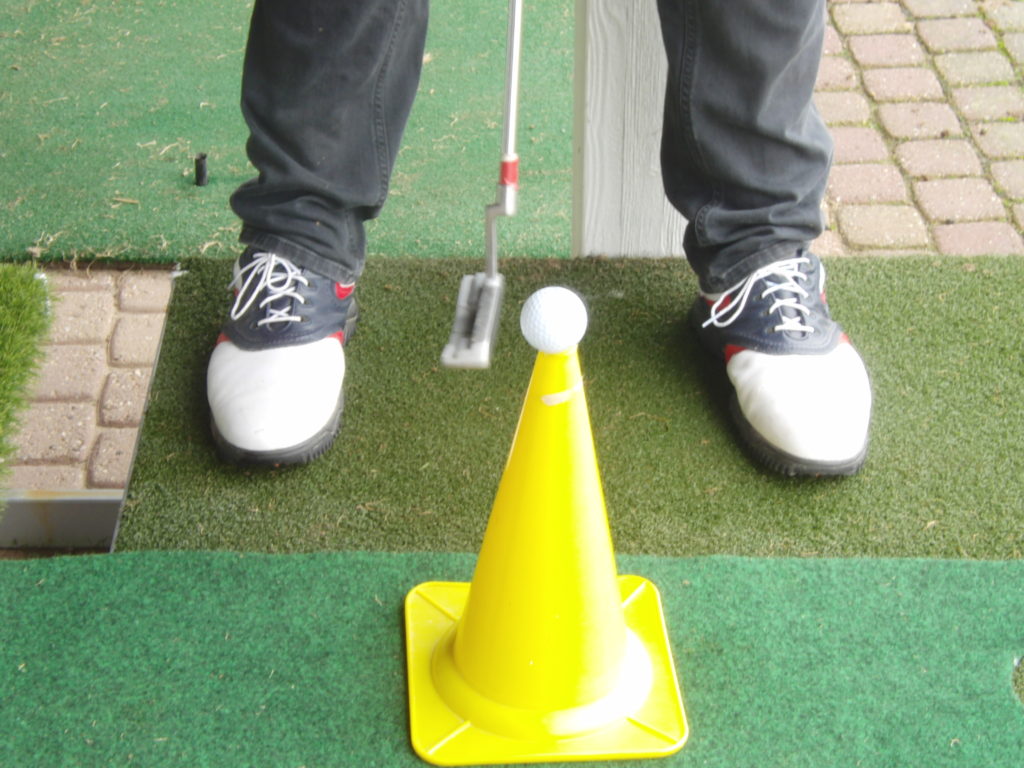Our perceptions as well as our knowledge lead to our experiences. What you see is what you get.
What you see is what you get.
Yips is "only" a disturbance of sensory systems. The athlete has no clarity anymore.
According to my research results YIPS is an unconscious and partly learned disturbance of the sensory system. Due to protective reflexes of the brain, joint blockades occur in specific movement situations.
The execution of the movement is often characterized by panic, restlessness, cramping or even hectic. The athlete experiences a short-term kind of blackout.
The independent movement pattern Yips is very often linked to specific situations, such as competitions, public, wind direction or even course design. Here, the feeling of insecurity, threat and the associated release of adrenaline as well as context-specific learning play a decisive role. Certain brain areas such as the insular cortex are involved by linking emotional processes.
The yips phenomenon may therefore not occur at all or rarely during training.
Mastering yips is similar to learning a new complex movement sequence. This training to break bad behavior patterns takes time and high quality practice because conditioning processes must be broken.
Perception is the path to mastery.
Irregular and stuttering movements are the result of incorrect perceptual processes before the movement is triggered.
"The whole is more than the sum of its parts." (Aristoteles)
In a YIPS response, specific muscle groups are targeted in isolation and used just before impact. Something "happens" too early. Arthrokinetic reflexes can also play a role in this.
- YIPS are a natural reaction of the human being (the athlete) to perceptual processes in connection with stress during the movement process
- In many sports, YIPS usually manifests itself in nervous and/or cramped hands during the execution of a movement.
- The position of the wrists in the impact area are uncontrollable
- Often the dominant hand is affected
- The athlete experiences a " powerlessness " over his body control during the movement or even before the start of the action
- YIPS are context-specific and can occur sporadically or chronically
- YIPS can lead to significant performance losses
Impact Panik
sporadic and chronic impact panic
I also use the term "impact panic" for the problem of the collision between club and ball in golf and tennis. (Impact-Panic)
In my experience, any person (athlete) has experienced a sporadic movement disorder. As a result of a chronic occurrence, the unsteady hands become a serious problem for the person (athlete).
psyche
Emotional processes such as disappointment, anger, fear of failure or embarrassment intensify and consolidate the YIPS symptomatology.
Poor ideas of motions are the "Performance killer" in sports.
With professional help YIPS are a fixable problem. The goal is to regain holistic movement to be controlled and executed.
In an interview with Golfjournal (2017) you can learn more.
zum Artikel: "That's where the pure desperation comes out".
YIPS in ultrasound - chaotic movements of the forearms
This is what shaky hands (YIPS) look like in the putting motion (measurement based on ultrasound with SAM Puttlab):
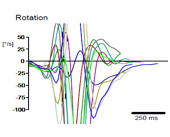
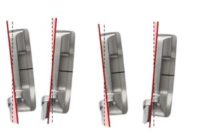
The graphic shows the disturbance of the face rotation in the forward swing during putting-YIPS. The colored lines are ten different putts that reflect uncontrolled clubface rotation. This "chaotic" behavior of the clubhead makes the result of the stroke random. The swings illustrate the loss of a holistic movement structure.
The forearms act in an involuntary sequence of pronation and supination.
Causes of YIPS
The causes for the occurrence of poor perceptual processes are manifold. For example, breaking down the movement into individual movement components and consciously training single-part impulses can make holistic movement control difficult. Repeated failures can lead to a significant movement disorder such as the YIPS phenomenon.
» weakness in the game: Yips often show up in the actual or perceived weakness of your golf game. Here, an poor or technically deficient playing technique can play a role and lead to unsteady hands during the movement.
» increased stress level: This can be unconscious stress outside and inside the game of golf. These include, for example, injury problems or the change of technique.
» disgraceful failure: During your round of golf, you experience one or more embarrassing misses in a particular area of your golf game, such as short putts or chips. The perception of the misses may be amplified by the public attention of fellow players or spectators during a tournament.
» stereotype training: A high and one-sided training workload can lead to overloads and bad perception processes in the playing technique. Motor experiences from other impact sports such as tennis or squash may also lead to negative transfer effects such as overactive hands / forearms and the loss of holistic movement control. A striving for perfection increases the onset of YIPS symptomatology.
» bad imaginations: "Linear" thinking as well as trying to swing and hit "straight" are other entry scenarios into the Yips cycle.
» analytic-sythetic training:The (excessive) practice of partial impulses, the (conscious) dissection of a holistic movement structure into individual components as well as the conscious control and intervention in a flowing movement sequence can stimulate the onset of YIPS symptomatology. The compulsive practice of so-called neutral swing elements, such as a conscious launching of the golf club on the club plane, can also be the entry into a movement disorder.
The mentioned aspects are the ideal ingredients for the perfect "YIPS cocktail"...and for the development of a impact-panic
Putting-YIPS
putting-problems & shaky hands during putting
Putting-YIPS
Three-time major winner, Tommy Armour formulated the term YIPS in reference to his putting problems and ended his professional career at age 41 due to chronic putting YIPS.
The career of Germany's most prominent golfer - Bernhard Langer - has also been nearly ended several times by recurring YIPS. For example, at the British Open in 1988, he needed five strokes to hole the ball from a distance of one meter on hole 17!
players affected
Ben Hogan, Sam Snead, Jonny Miller, Tom Watson, Mark O`Meara or Ernie Els are other well-known professional golfers who had or have putt problems related to YIPS.
symptomatology
- The movement disorder manifests in the forearm area of the dominant hand in most affected individuals
- However, YIPS symptomatology can also manifest in the non-dominant arm side or even appear in both hands.
- The twitching or trembling in the forearms occurs in many cases during the approach phase of the club to the golf ball
- Short putts consistently miss the hole by a small margin
- With longer putts, YIPS-afflicted players lose control of the correct measure. The balls remain clearly too short or overshoot the hole
- The ball is also increasingly hit on the inside of the club face, so-called sockets / shanks
- Control over making "clean" contact with the ball has been lost. An impact panic has built up
- The affected players usually have a good to very good feeling for the ball and practice regularly.
diagnostic
A kinematic measurement with the ultrasound-assisted SAM PuttLab 3-D motion analysis system from the company Science and Motion (http://www.scienceandmotion.com/) is recommended. The device calculates 56 stroke parameters. For the diagnosis of unsteady hands, the measurement of the behavior of the club head rotation in the forward swing is suitable.
SAM PuttLab station
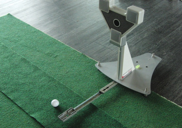
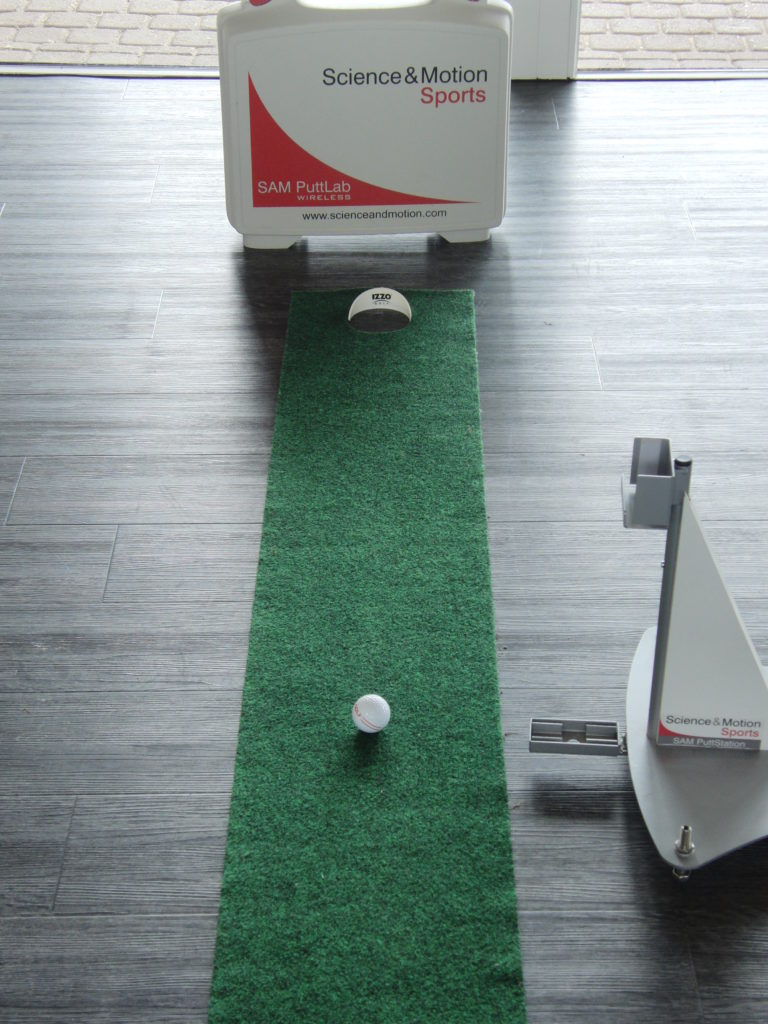
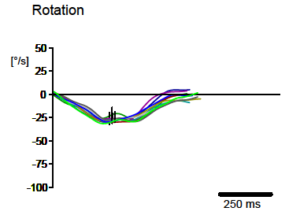
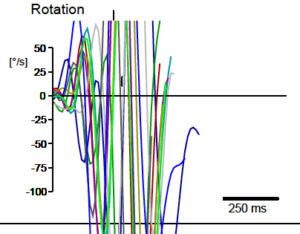
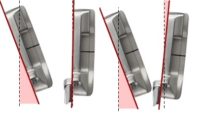
YIPS-test hit performance
As an alternative or in addition to a SAM PuttLab measurement:
a) five putts each one-handed with the left side of the arm as well as
b) putted with the right side of the arm from a distance of one meter to a hole without a break
At least four balls should be holed from a distance of one meter with both the left and right sides of the arm. The one-handed putting test makes the YIPS symptoms more noticeable and visible to the individual.
Solutions and help: yips-free to a High Performance Puttstroke
Support 1: Recovery of a holistic movement structure - Reprogramming
Solution: passive arms in the swing and relaxed wrists in the impact - guidance via the "big" muscles (shoulder/torso) and from the ground reaction forces. Arms act as a follow through movement.
Goal: A dorsiflexion of the right wrist (for right-handed players) in specific swing phases.
The first intervention path has the claim to get fine motor skills under control within a certain period of time through an individual Anti-YIPS training. Daily practice shows that every YIPS-affected person is able to perform an undisturbed putting motion again under certain conditions.
A simple example: during practice putts without the ball, the hands are usually steady.The golfer experiences a freewheeling, holistic movement.
Further reprogramming - exercises to create a yips-free movement:
- The golf ball is tucked under the foot and touched with the club
- The golf ball is put down freely and touched only with the club
- The golf ball is played as a "micro putt" - only a few centimeters away
- conscious training of a dorsiflexion of the dominant wrist side in specific swing phases
- Putting with swing triggers - e.g. the conscious use of leg impulses
- Introduce and use fade or draw swing patterns
relearning and beating the YIPS
The regular and systematic execution of the so-called "reference movements" with and without the coach leads to a relearning process.The affected golfer experiences and learns (again) a holistic movement control with a harmonious
The specific putting exercises are checked for success with the highly sensitive SAM PuttLab. Regular checking of the kinematic data documents the success of the treatment.
Best Practice Putt-YIPS: To the solution example
help 2: grip change
A further and complementary possibility to the individual anti-YIPS training is a change of grip. Here, the hand affected by YIPS, i.e. usually the right hand in the case of right-handers, is positioned in an unusual position.
For some professional players (e.g. Sergio Garcia) the claw grip has proven to be successful. Other grip variations for tour players: (click here)
Another alternative: clap hand with the dominant hand side: i.e. the palm leads - the fingers are completely spread out.
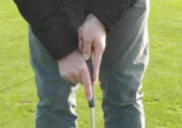
It is recommended to carry out Anti-YIPS coaching in addition to grip modification. It has been shown in practice that unsteady hands can occur despite grip changes.
help 3: change the direction of movement
Another and more radical possibility is to change the playing technique to the "other side". I.e. here the right-hander retrains to left-handers and vice versa. Here, too, there are many variations in the grip.
In my experience, this change of "movement side" is a chance to set an extreme change impulse and thus to weaken or eliminate YIPS. Disadvantage: relearning to the other side takes a lot of time and the development of a successful feeling for the stroke on the unfamiliar playing side is not guaranteed. This radical change is technically easier to implement in putting than in chipping or pitching.
There is a risk that YIPS will show up on the other side as well.
Anti-YIPS Coaching: report of a golfer
Putting-YIPS from the point of view of an affected player
For me, putt-YIPS was a gradual process that went unnoticed at the beginning. It started with twitching during short putts. It was ignored. Over time, I'm talking about 1-2 years, I sometimes couldn't breathe when I putted and my feet shook as if I were doing a tap dance. My putts were completely numb and uncontrolled. Putts from a distance of 50 cm were sometimes meters behind the hole. On longer putts I could not move my arms and the putt ran 3-4 meters, but the hole was 10 meters away. A phenomenon was, practice swings on the green and putting on the practice green were always fine and loose. Then I got a tip that in Cologne, a trainer has scientifically researched YIPS at the Sports University of Cologne.
I contacted Mr. Gerland by phone and made an appointment. Puh, the first conversation was already very pleasant, finally someone who talked competently with you about YIPS and knew exactly how the other thinks and feels.
My putting motion was then measured with a PC program specially developed for this purpose. The deviations of the measured curves from the upswing to the completion of the putt were very serious.
The analyses showed that the YIPS is present exclusively in the right forearm and is not a psychological problem.
From then on the work began.
Putting exercises, almost always with the right arm, from different distances, against a pendulum, with specific shoulder support, with the tip of the putter, concentration exercises, etc. All specific exercises against YIPS. Success was achieved. During the repeated measurements with SAM Puttlab, the deviations became smaller each time, so my putting became much more consistent and fluid. It is a really sublime feeling when you see in black and white (o.k. the curves are in color) that things are getting better. However, I often practiced the special putting exercises at home (about 10 minutes a day).
My putts on the green have improved enormously again. I feel them and can control them again. Mr. Gerland also says quite openly that YIPS does not go away completely, it comes back out of nowhere. That's right! It is enormously helpful to be prepared for it and to be given the appropriate exercises to perform.
Inquiries gladly by telephone
Hans Ammermann
Tel. 0049 (0) 177/3271442
Driver-YIPS or
Full-Swing-YIPS
The term YIPS is generally understood to refer to shaky hands when putting. However, the phenomenon also occurs with other golf techniques. In my many years of experience as a coach, the YIPS phenomenon is most often seen during the full swing. This includes the tee shot in particular.
It can be assumed that a large number of players are affected without knowing about it. Many described tee-off problems could be related to YIPS. Allegedly the former British Open winner Ian Baker Finch as well as the former No. 1 of the world ranking list David Duval are or were affected by Driver-YIPS.
Henrik Stenson, multiple winner on the PGA Tour and British Open winner in 2015, talks openly about his Driver-YIPS and the problems it causes, up to and including the impending end of his golf career (click here). Hank Haney, Tiger Woods' former coach, faced the problem himself for over ten years. He suspects that Tiger Woods also had to struggle with Driver-YIPS.
symptomatology
The intention to hit straight and far can lead to an unconscious "misdirection" especially of the hip in the downswing. The hip reacts too early to the countermovement towards the target.
The movement sequence is disturbed. The ground reaction forces are not used correctly. And similar to the putting situation, the musculature reacts to the impending ball contact and changes the tension and composure.
The golf swing is primarily from the arms. Consequences: Hits on the heel of the clubface (sockets/shanks), powerless shots, quick hooks or extreme push slices to the neighboring fairway.
Control of the driver is completely lost. However, the wrong movement pattern often works on the driving range (without stress/adrenaline). Arm control can work here.
diagnostic
Tee-shot-YIPS, primarily with the driver, is difficult to diagnose. Due to the high clubhead speed, Driver-YIPS is usually not detectable to an outsider. Even the affected player may not feel the Driver-YIPS and misclassify his problems when teeing off.
Hints of tee shot-YIPS:
- Indications for a tee-off YIPS could be the strikingly different ball flight curves. I.e. the golfer "loses" his balls on the right half of the fairway (slice) as well as on the left half of the fairway (pull). The deviations are drastic (snap hooks/push slices) and cannot be explained by the existing technical skills of the affected player. Even video recordings or TrackMan measurements cannot sufficiently decipher the alternating occurrence of the contrasting stroke patterns.
- Driver - Statistics of Tiger Woods at the US PGA Tour tournament in Torrey Pines (25.01.-28.01.2018): 30% hit fairways from the tee, 64% of the tee shots missed right and 36% missed left the fairway.
- Sockets/shanks with the driver and the irons. The ball is sometimes hit only slightly on the heel of the club face/inside of the club face. This could be an indication that the driver head moves "lurching" to the ball, similar to the chaotic putter head rotation during putt-yips. As a result, directional control becomes random.
- "Fat" or "thin" hit tee shots with the irons are also anomalies that can be signs of unsteady hands if they occur more frequently.
- On the driving range, the aforementioned glaring misses rarely, if ever, show up. This is an indication that the Driver-YIPS is often linked to the special psychological situation of the tee box. Examples include increased attention from teammates or a compulsion to want to hit particularly far and accurately.
Solutions and exercises - the search for passive arms
The driver YIPS is characterized by an involuntary change of the clubface shortly before or during impact. Here, turning the hips too early in your downswing, restlessness in the forearms just before the impact, and "oversteering" the movement from the arms plays a significant role.
The solution approaches follow the examples from my research work on putt-YIPS. The different factors influencing the clubface have to be trained specifically. Conditions should be created under which the stroke runs rhythmically, fluidly, smoothly and consistently again with the goal of having an undisturbed movement in and in front of the impact point.
Goal: passive arms
exercises
- Sidesteps beim Ausholen und beim Abschwung: Nutzen der Bodenreaktionskräfte – der Schwung wird über die kinetische Kette von unten nach oben ausgeführt. Die Arme bekommen dabei die Funktion einer „Nachfolgebewegung“ und bleiben passiv.
- active extension of specific leg muscles towards the Impact.
- conscious training of a dorsiflexion of the dominant wrist side in specific swing phases
- Shift and Turn Übungen
- Top of the Backswing: Extreme look over the shoulder and then a recentering of the upper body toward the target. It must feel like the body is tipping into the ball. The arms follow this impulse of movement and have been "flung".
- Create fade or draw swing patterns - "straight"/linear thinking and swinging are to be avoided
- Grip adjustment with the leading hand during the drive in the direction of a fade grip
Chipping-YIPS
The YIPS problem also manifests itself in the short game. Under certain circumstances, the symptoms have shifted from the putting to the short game or both areas of the game are affected at the same time.
Even very successful professional players, including Tiger Woods, are repeatedly associated with Chip-YIPS or a precursor.
symptomatology
- The golfer regularly has noticeable problems with the short approach shots (chip, pitch, bunker shot).
- Often "fat" and "thin" strokes alternate with each other.
- Success depends on ball position ("teed up" vs dry or muddy)
- Also so-called sockets/shanks, the Hitting the ball at the club heel, can occur more often with Chip-YIPS.
- Success depends on competition pressure/spectators
In the short game, the error tolerance is very low. The smallest irregularities at the point of impact can already have drastic effects. The results are no longer calculable and do not correspond to the performance level of the affected person. Muscle twitching and failure of motion control is noticeable in some players and leads to failures at the level of beginners.
pressure to play and compete
The special pressure situation in the short game, for example bad lies of the ball, sometimes even leads to movement disorders. The player "freezes" in the movement, the so-called "freezing" or stops during the movement to the golf ball. However, the muscular reaction is not so obvious in all sufferers. In addition, the Chip-YIPS may also only occur in a context-specific manner, for example in a tournament or with a specific lie of the ball. This makes diagnosis difficult, and problems in the short game are not associated with the YIPS-phenomenon.
Solutions and Help
Certain weaknesses in the playing technique of the short game can be, among other things, the entry into the YIPS problem. For example, an isolated swing from the arms, a flat take away of the club or too little use of the bounce of the club sole at the moment of impact.
If the unsteady hands are always present in the short game, specific Anti-YIPS coaching with the aim of achieving holistic movement control will help.
- Search for conditions and, above all, ideas under which the approach stroke is holistic and thus trouble-free
- Fixing the hip movement in the downswing - the hip must remain passive in a certain time window.
- Solution: passive arms in the swing and relaxed wrists in the impact - guidance via the "big" muscles (shoulder/torso) and from the ground reaction forces. Arms act as a follow through movement.
- active extension of specific leg muscles towards the Impact.
- conscious training of a dorsiflexion of the dominant wrist side in specific swing phases
- Create fade or draw swing patterns - "straight"/linear thinking and swinging are to be avoided
- depending on the ground conditions, the bounce of the golf club is used consciously
- Shift and Turn Impulse
- Reprogramming by consciously applying a so-called trigger emotion at the start of the swing.
- Change of the mental attitude to the chip or pitch
- Use of analogies to simple and known movements e.g. frisbee through
DR. BERND GERLAND ∙ PGA MASTERPROFESSIONAL ∙ COACHING
TEL: +49 (0) 170 / 47 67 348 bernd.gerland@gmx.net
Golfanlage St. Urbanus ∙ Urbanusstraße ∙ 51147 Köln


